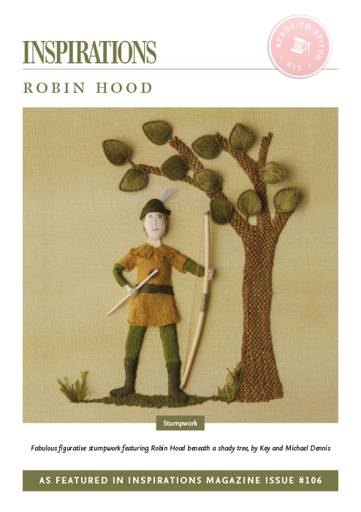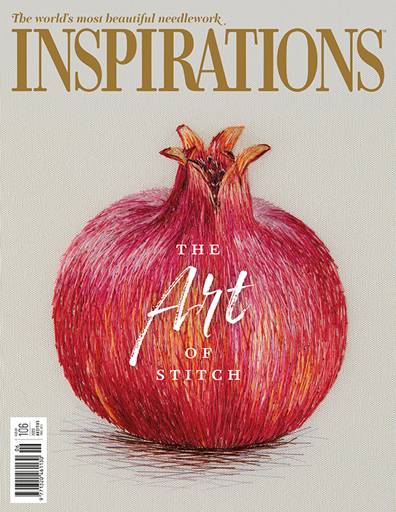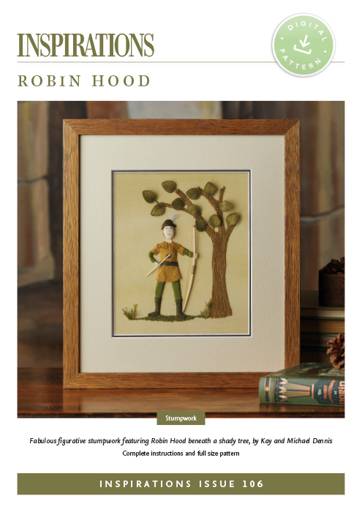Robin Hood by Kay & Michael Dennis
15TH MAY 2020 - ASU #234
Most embroiderers are comfortable stitching flowers, animals or landscapes. But what about stitching people?

Many of us will avoid trying to create figures due to the complexity of the human form. It isn’t just getting the limb position and proportion correct, which can be harder than it looks – getting the face right can be downright frightening!
A stitch placed just half a millimetre out can, at best, change an expression completely. At worst, it might make a face just look wrong.
But back in the 17th Century, stitchers didn’t seem to demonstrate such fears. Stumpwork figures were worked frequently on caskets, bed hangings and panels. In fact, the addition of a royal, biblical or allegorical figure was necessary to tell a story or commemorate an event.

When we look at stumpwork figures from the past, we are as charmed by their naiveté as we are stunned by their detail. So, what holds us back from stitching more of them today?

Fortunately, Kay and Michael Dennis are masters at creating stumpwork figures and encourage all embroiderers to give them a try. Robin Hood is the perfect figure to start with. Yes, care must be taken in shaping the face and constructing the hands – the two things which will be the difference between a figure looking human or not.

But as soon as one accepts that their Robin Hood will have a unique personality and facial expression, unlike any other person’s Robin Hood, then one has opened themselves up to the joy of this technique.

There are very few human beings who are completely and indistinguishably identical to another. The same goes for your stumpwork figures. For their project ‘Robin Hood’ from Inspirations issue#106, Kay and Michael provide step-by-step instructions to create Robin’s face and hands, but the formation of the shapes and placement of the stitches will be yours alone.

If he doesn’t look right, try again until you catch him gazing out at you from the fabric, assuring you that he’s happy with how he looks.
Of course, human figures are not just hands and a face – they are clothing and stance as well. In the 17th Century, great care was taken with the drapery and clothing, ensuring that it admirably represented the kind of clothing such a royal or revered figure would wear. Needlelace was used frequently due to its versatility, and that is precisely how Robin Hood’s tunic and leggings are created.
 LEFT: Up and Down Stitch RIGHT: Corded Detached Stitch
LEFT: Up and Down Stitch RIGHT: Corded Detached Stitch
Stumpwork figures allow you to experiment with a whole range of different techniques from soft sculpture to wire work, needlelace, embroidery techniques and the fascinating addition of little props like Robin’s bow and arrow, constructed from cocktail and satay sticks!
Once you’ve tried it, it will open you up to a world of possibilities. Experiment, design, create your own figures, each with their own individual personalities.
Part of being an embroiderer is pushing beyond your boundaries or comfort zone and trying something new.

Stumpwork figures were essential to our stitching ancestors and provide a rich subject matter for stitchers of today.
Why not start your own journey with Robin Hood. He will then proudly look upon you, hand on hip and a subtle smile on his face as he watches you take this wonderful technique and run with it.
Make Your Own Robin Hood

Step 1 – Purchase Project Instructions
Robin Hood by Kay & Michael Dennis is a fabulous figurative stumpwork featuring Robin Hood beneath a shady tree.
Step 2 – Purchase Ready-To-Stitch Kit
The Inspirations Ready-To-Stitch kit for Robin Hood includes everything* you need to re-create this wonderful scene: Fabrics (unprinted), wool felt, leather, wires, fibre-fill, toothpick, satay stick, feathers, adhesive film, embroidery threads and needles.

Kit
Robin Hood - i106 Kit
Shop Now*Please Note: To cater for flexibility of purchase, instructions are not included with our kits. For step-by-step directions on how to create this project, please refer to the magazine/digital pattern.


